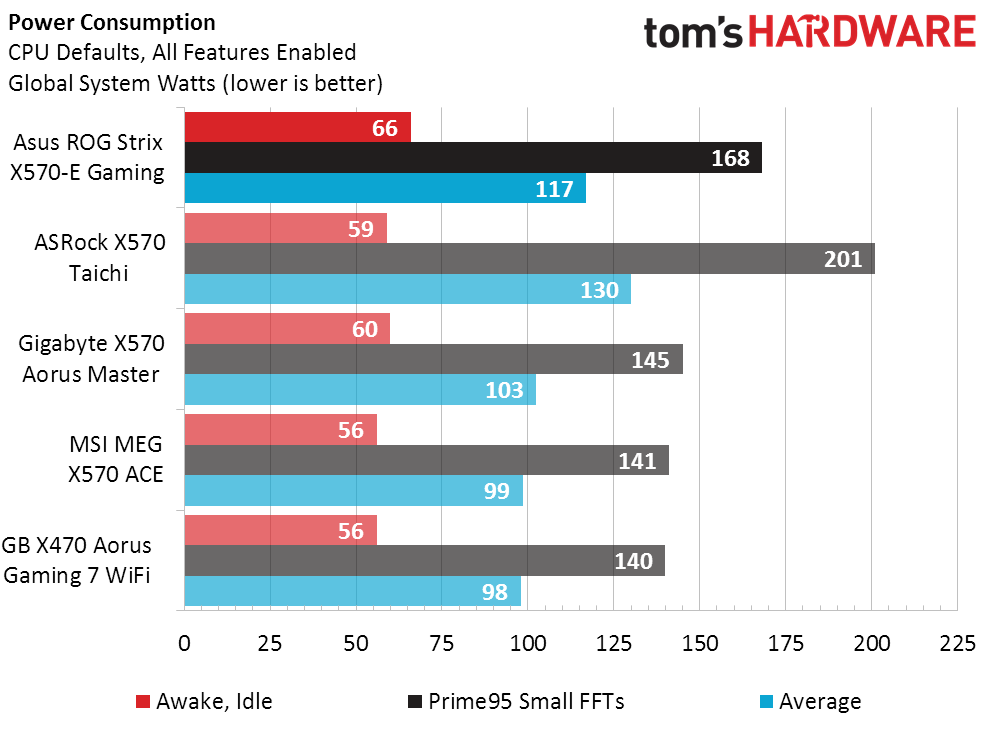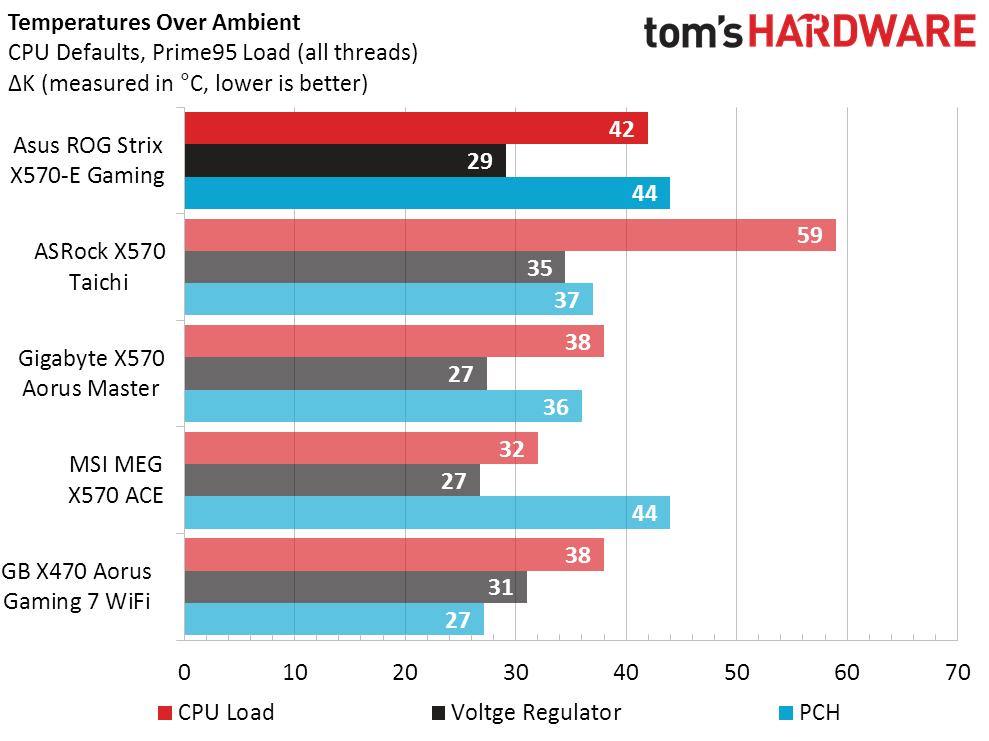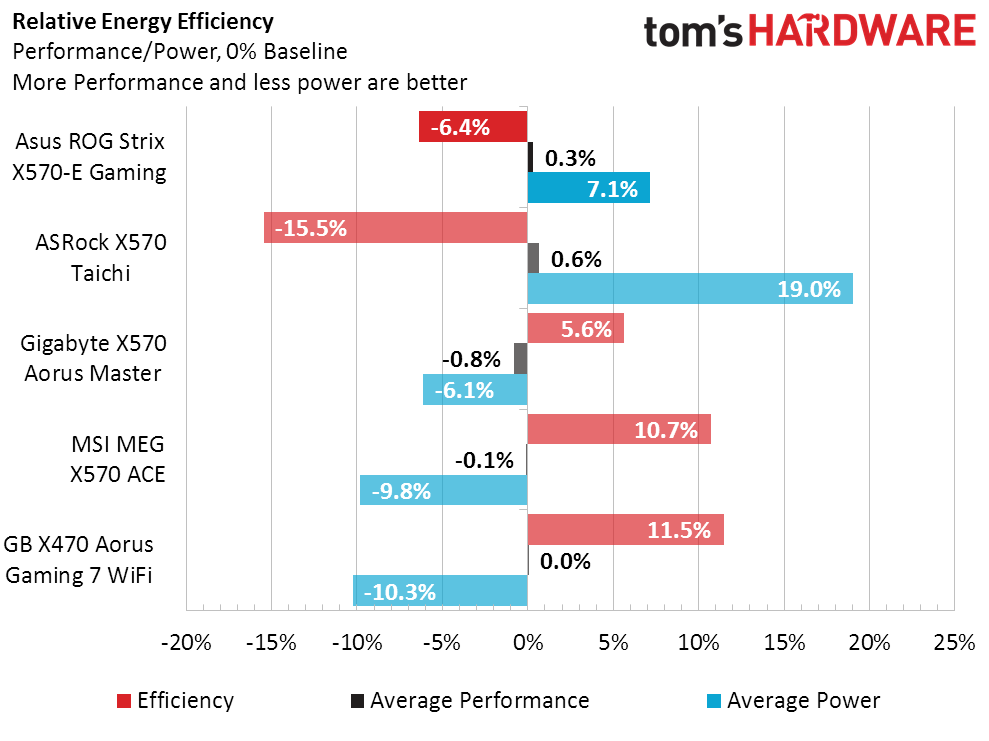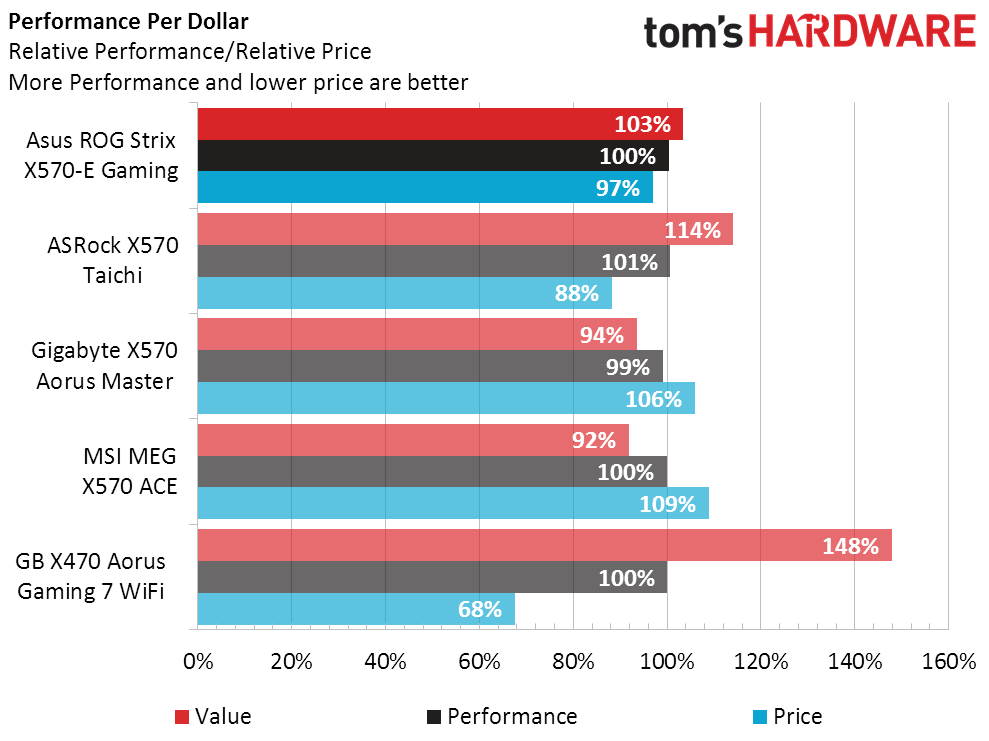Asus ROG Strix X570-E Gaming Review: More Fast USB, Lower Price
Asus undercuts MSI and Gigabyte for enthusiast-class X570 pricing
Why you can trust Tom's Hardware
Benchmark Results and Final Analysis
Gigabyte’s GeForce RTX 2070 Gaming OC 8G and AMD’s Ryzen 7 3700X update the hardware configuration of our most-recent X470 test system, while a newly configured test suite brings all the compatibility benefits of Microsoft’s latest Win10 patches.
3DMark and PCMark
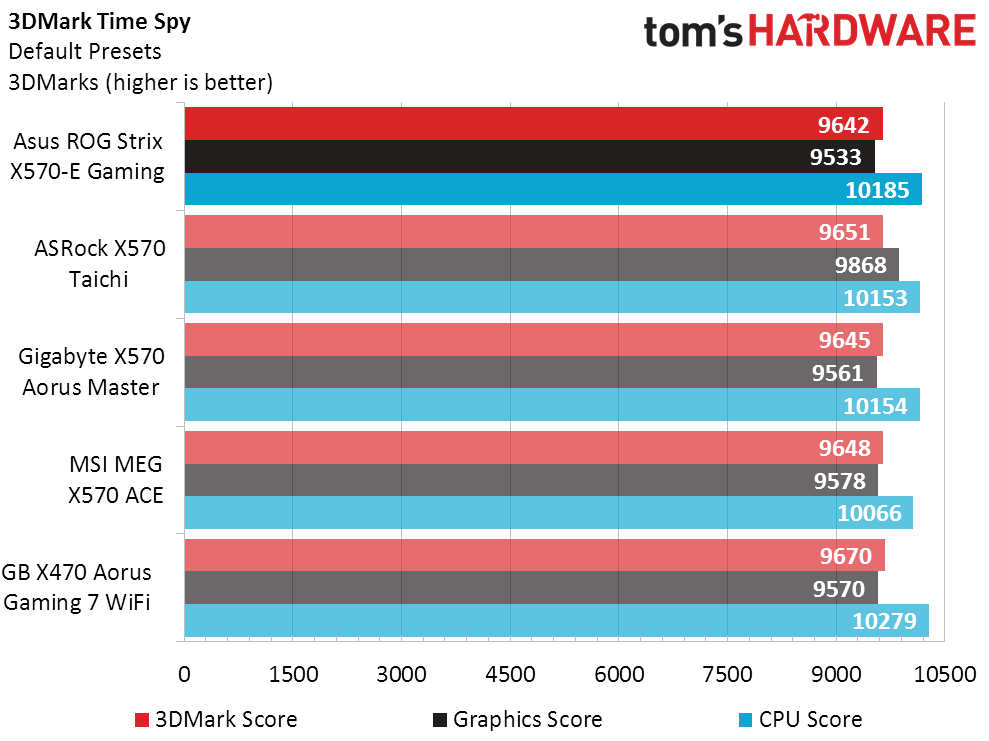
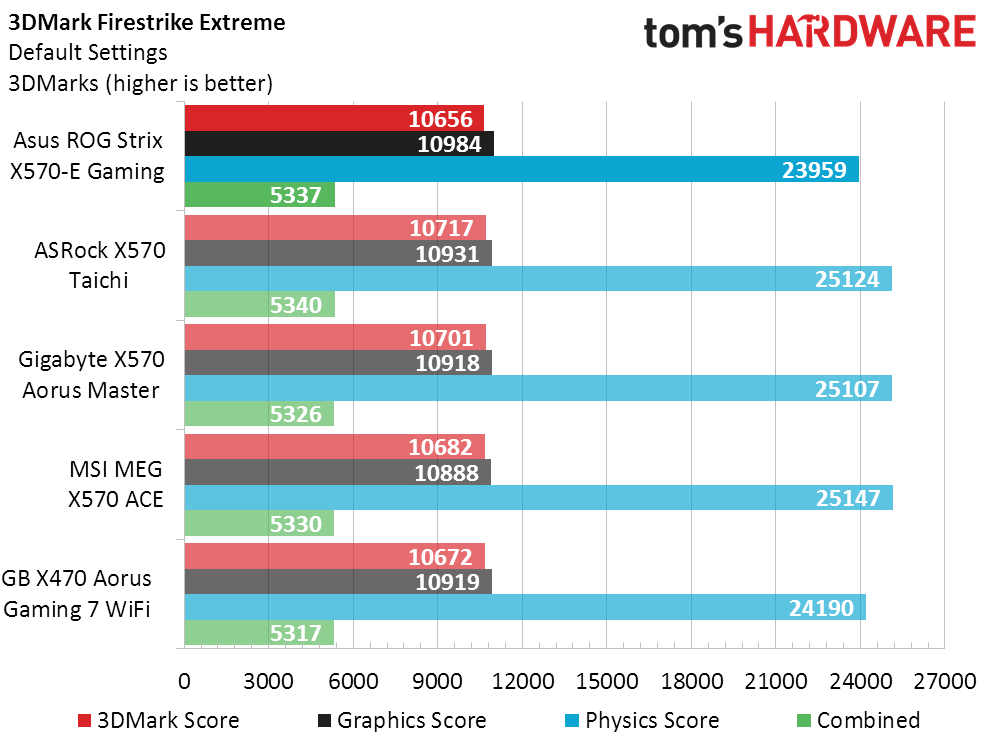
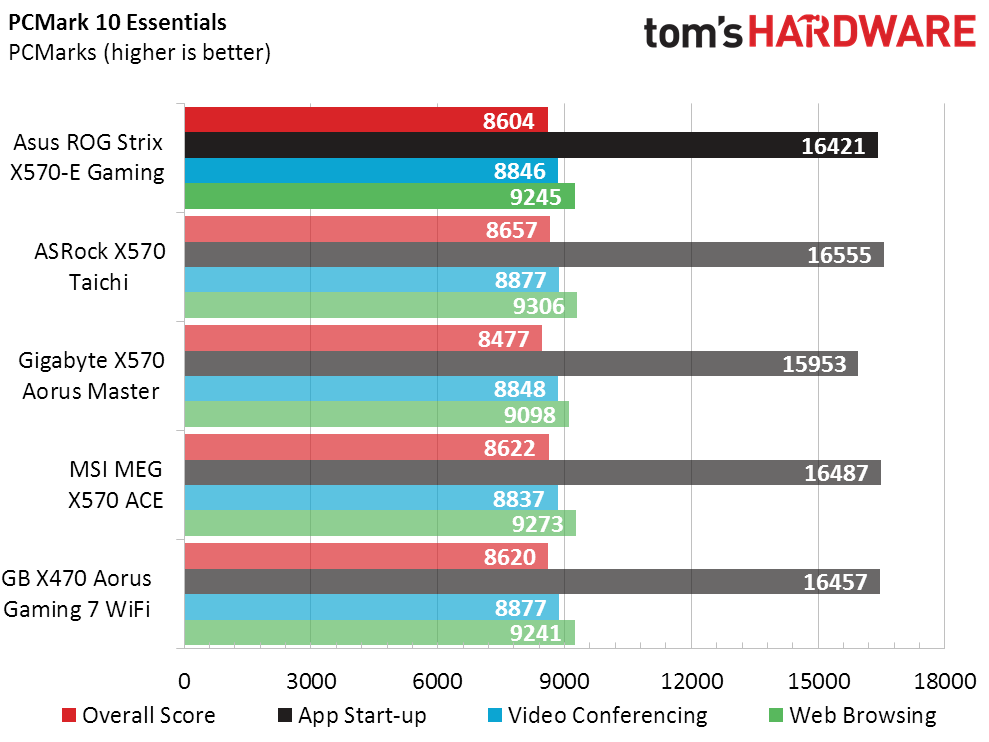
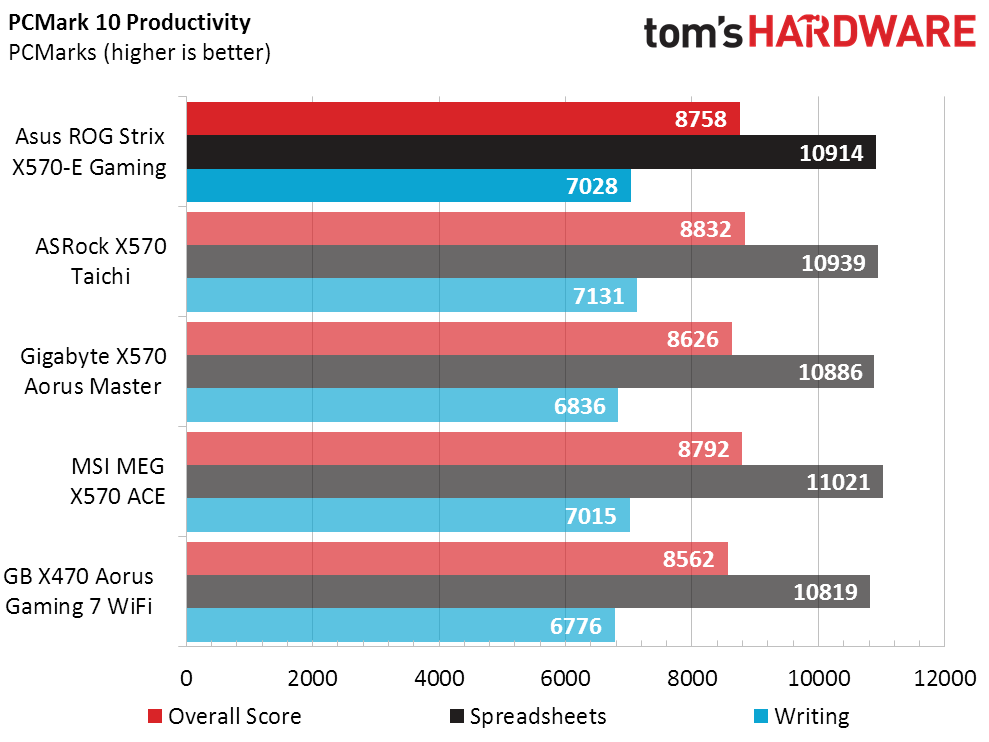
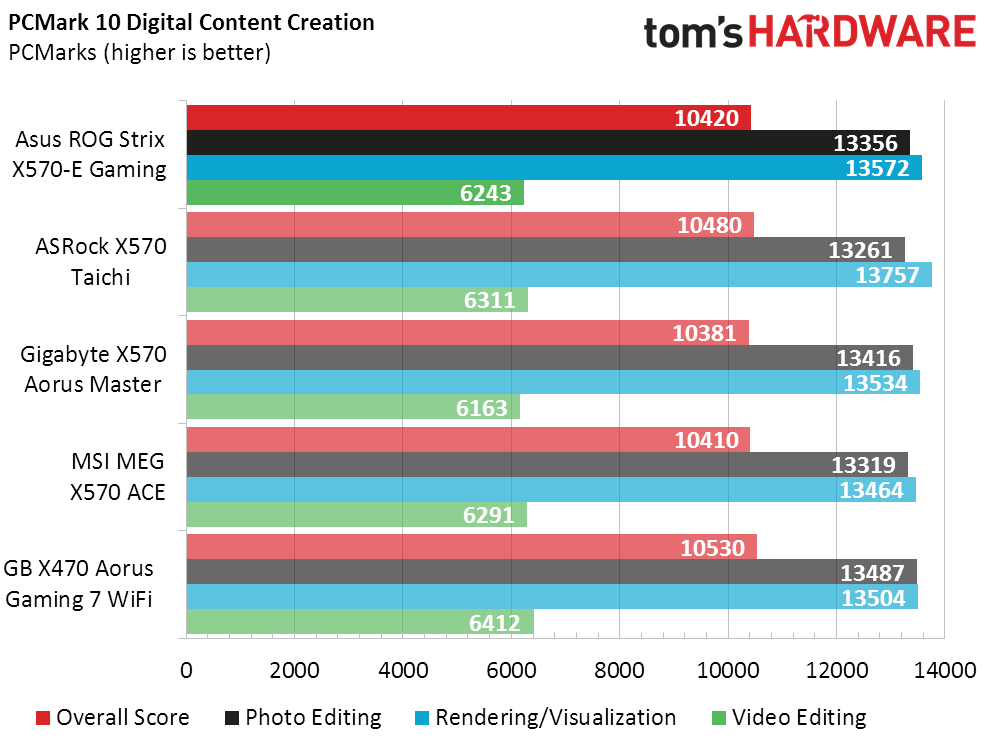
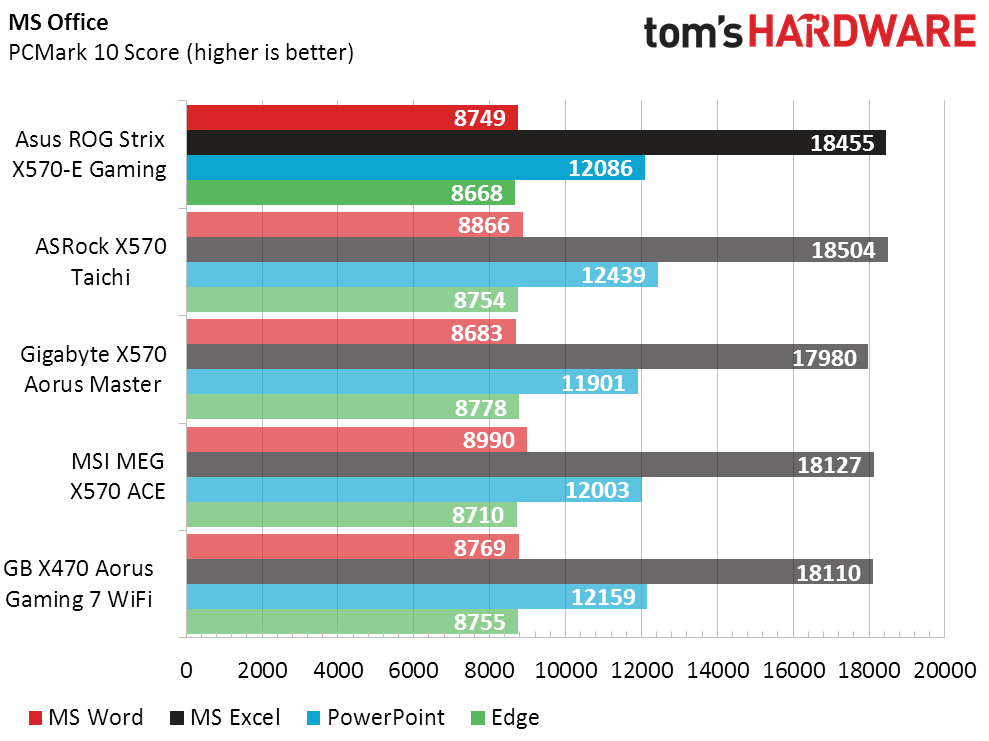
The Strix X570-E Gaming falls behind in the Physics score of Firstrike Extreme, but produces par performance in nearly every other test. Let’s see if that single difference is reflected at all in games.
3D Games
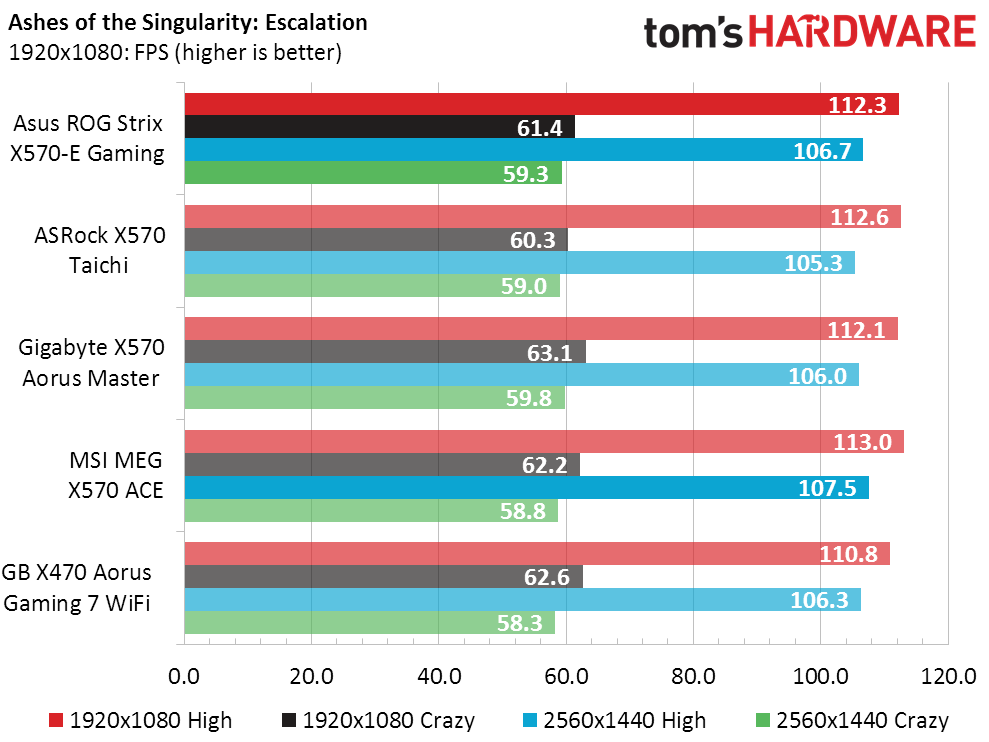
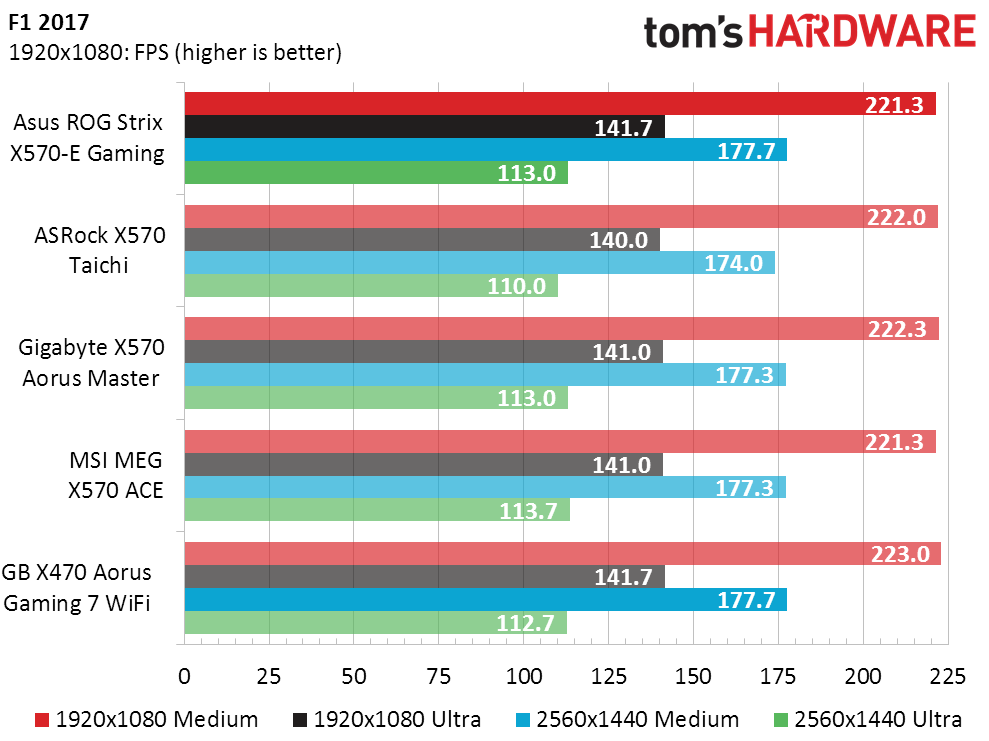
The Strix X570-E Gaming comes up in line with the competition again in our CPU and DRAM bottlenecked gaming titles. Perhaps we’ll find a difference in encoding applications?
Mixed Apps
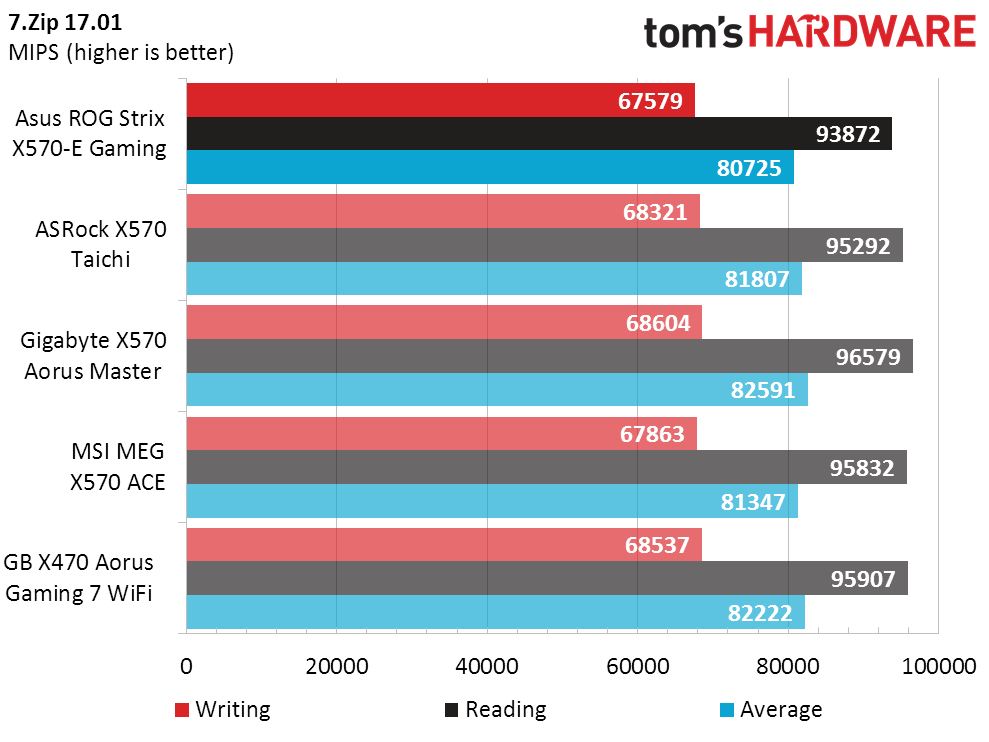
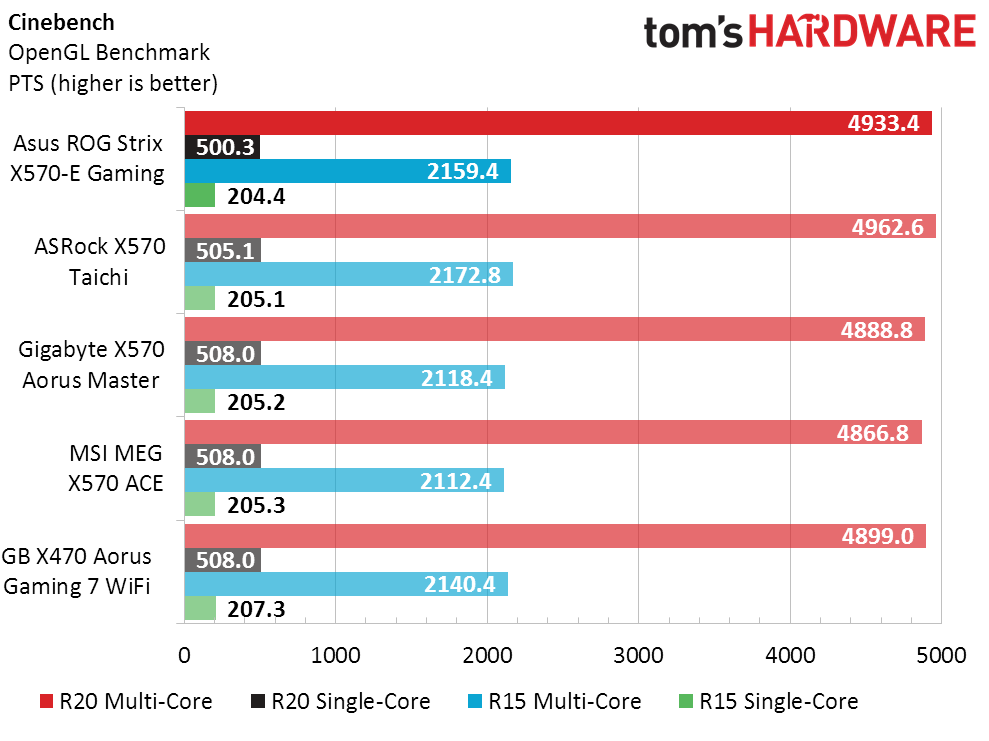

We’ve seen enough competitive results from the Strix X570-E Gaming to dismiss its loss in only one synthetic benchmark as a likely hiccup within the benchmark itself. Will it stand out better in efficiency?
Power, Heat And Efficiency
The Strix X570-E Gaming scores here as the second-most power-hungry board, and a look back at our test notes reveals that it ran between the Taichi’s 4.1 GHz and the Aorus Master’s 3.9 GHz, and at 3.95 to 3.975 GHz, in Prime95. We’re not sure why it didn’t idle down to a lower number, though.
The Asus board had the second-highest full-load frequency and the second-highest full-load power consumption, and it also produced the second-highest thermal measurements. Concerning the voltage regulator, the results shown are from an infrared scanner that reported the highest temperature at the chokes: The Strix X570-E Gaming’s software reported the lowest MOSFET temperature at 10° over ambient, for what that’s worth.
Differences of less than half a percent are hard to track in individual benchmarks, but the average of these put the ROG Strix X570-E Gaming in second place to the X570 Taichi and farther ahead of upmarket models from Gigabyte and MSI. That small boost in overall performance loosens up the efficiency deficit of its relatively high energy use, so that it finishes between the Taichi and Aorus Master overall.
Get Tom's Hardware's best news and in-depth reviews, straight to your inbox.
Final Thoughts
As the second-cheapest board in our lineup, the ROG Strix X570-E Gaming produces the second-greatest performance per dollar. With its 2.5GbE secondary Ethernet controller, WiFi 6 controller and bundled remote thermistor, it’s far closer to the X570 Aorus Master in features than to the X570 Taichi, and it beats all comers when it comes to USB3 Gen2 port count.
The Strix X570-E Gaming splits the difference in price between the Taichi and the Aorus Master, taking the trophy in features for the money. This, despite its lack of a third M.2 slot, since the Strix board focuses instead on having eight SATA ports. While it may be difficult for some of us to fathom substituting four SATA ports for a third NVMe interface, we’re sure that someone out there plans to build with more than four SATA, and no more than two M.2, drives.
That ideal buyer sounds more like power user than a gamer. But the marketing aim being a bit off doesn’t detract from this board’s features and abilities. The ROG Strix X570-E Gaming offers an advantage over competing X570 boards in features-per-dollar, making it easy to recommend, unless of course you need to install a trio of M.2 SSDs without the use of an expansion card.
Image Credits: Tom's Hardware
MORE: Best Motherboards
MORE: How To Choose A Motherboard
MORE: All Motherboard Content
-
rolli59 Good review but still awaiting reviews of sub $200 boards,Reply
Have been building for years and never needed a board over $150. -
Crashman Reply
With X570 you'll be saying you never needed a board over $200 :) We have someone working on that for you.rolli59 said:Good review but still awaiting reviews of sub $200 boards,
Have been building for years and never needed a board over $150. -
Badelhas Good review but these x570 motherboards are way too expensive, in my opinion. I wont buy a 300+ motherboard to go with the 200$ Ryzen 3600...Reply
When will Toms Hardware make an analysis of the current situation when pairing the great value Ryzen 3600 with the cheaper B450 options motherboards?
Cheers -
rafaelramax Thanks for the great review!Reply
I guess this is a solid competitor of its class. There are few minor flaws, like the lack of CMOS reset button on the rear and those dull M.2 covers. Asus did a good job here overall. Some smart moves like splitting the Fan headers across the board and providing the SATA ports in a 90º placement helps with cable management, maintenance, air flow and even aesthetics. I get the feeling that there are some disposable things that could get the price a little lower, hence the video outputs and the heatsinks-everywhere approach should be revisited. Each mobo of this tier tend to offer somewhat distinct set of features. This one clearly appeals to the all USB3.x and 8 SATA ports while very budget-oriented.
I was expecting an even more detailed analysis over the Power Delivery solution implemented on this mobo. I'm far from an expert, but Asus seems to adopt rather different scheme than other brands while not using doublers nor true independent phases either. Following power stage MOSFETs are rated to higher current and lower voltage in a two-per-phase design against the "true independent 12+2 phase" with one-per-phase MOSFET on the similarly priced Gigabyte Aorus Master. I wanted to see how either solution would fare against each other concerning stability and overclocking capabilities as there is too few updated info regarding this theme. The recent Aorus Master review pointed a slightly lower clock on (apparentely) the same piece of 3700X, but I think that are much more to be covered. I would like to know how the same CPU and RAM can be OC'd on each board with same voltage would be useful.
There are lots of issues I dislike about this trending marketing side of components and all mobos are included. Options are scarce for high-performance full-feature parts that doesn't add up a ton of aesthetic, illumination, bundled RGB and further RGB support, military, racing, gaming themes, with everything glowing. I always have to choose between getting features or getting plain elegant looks. That just proves that brands have terrible tastes. I really wanted to see the same products sporting sleek clean visuals versions, with no RGB whatsoever. The sole offer from Asus is the professional-grade with WS X570-ACE, but on higher price point than this Strix X570E, yet not as capable feature-wise. They just push this garbage along with their finest products to inflate prices and this is ridiculous. When those manufacturers mix that policy with this new platform we are presented to this inflated price scenario for Mobos. The cheapest X570 Mobos came with an outrageous MRSP US$200 that adds up nothing but PCIe4 and a always weird chipset fan. Many of those entry-level Mobos offer below average VRMs, USB/Sata/Fan ports count, connectivity options, with terrible Audio codecs. Speaking of PCIe4, the bandwidth uplift is useful only for already-announced-yet-soon-to-be-released SSDs, not even the recently launched GPUs will benefit from it. Previous generation Mobos with similar perks at launch were found for half the current price and that is infuriating. Opting to ditch my then US$150 Mobo will cost me US$300 to keep specs alike. This is roughly the distance between a 3700X and a 3900X.
With that in mind, I would like to suggest if you could provide us with more extensive analysis when pairing the new Zen2 arch with the mainstream boards equipped with older gen chipsets, like the B350, B450, X370 and X470. There's few content of the matter and, at least for me, it will be extremely useful. I was totally on the hype for Zen2 and was planning to replace my 2 years old 1700 with a 3700X. I didn't get one yet mostly because of availability and price of Mobos in my region and now I'm not even considering the X570 platform anymore. I guess many users are facing the same dilemma now.
Cheers! -
suddenstop Does the MSI board show the fastest memory overclock and then the lowest memory bandwidth? Can anyone explain that?Reply -
Crashman Reply
Secondary and tertiary timings are the most likely culprit: MSI uses more-stable timings so that the memory will overclock higher. When using a program that measures how fast a large number of packets are sent and received to rate bandwidth, the wait time between sends and receives impacts the bandwidth rating.suddenstop said:Does the MSI board show the fastest memory overclock and then the lowest memory bandwidth? Can anyone explain that?
This is how the MSI motherboard ended up being the one we used in memory reviews without being the one we picked for an award in this price class. The higher overclocks are better for memory reviewers than for actual users. -
Bagman 1972 I can't understand people and the reviewer balking at the lack of USB 2.0 ports on the back plate. They can be added so easily off the motherboard USB 2.0 header to the back of the case.Reply -
Crashman Reply
The argument against those who hate USB 2.0 is that it's a nearly-free interface that fully supports a keyboard and mouse. There's no reason to use more expensive parts to support two devices that nearly everyone uses.Bagman 1972 said:I can't understand people and the reviewer balking at the lack of USB 2.0 ports on the back plate. They can be added so easily off the motherboard USB 2.0 header to the back of the case.
